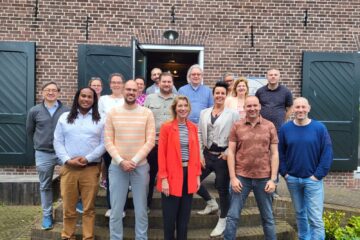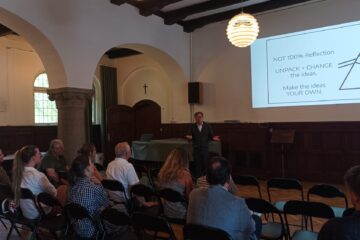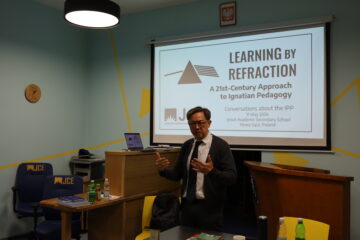This article is reprinted from the JCAP 2021 Annual Report. The author is Fr. Johnny Go SJ.
What makes Jesuit education Jesuit in the digital age?
In the last year, educators everywhere found themselves involved in an unforeseen global teaching experiment. As a result of the Pandemic and the resulting suspension of onsite classes in many schools, teachers had to quickly learn how to pivot to online teaching..
Few of our teachers had been prepared for this shift to off-site learning. In many countries in Asia Pacific, teachers scrambled to migrate to online learning, with little time to find ways to equip themselves with the skills to deliver their courses online.
Photo by Dr Cuisia Cruz
Understandably, many Ignatian educators were even initially reluctant to make the shift. Online learning was dismissed as inappropriate for Jesuit education, if not downright ineffective.
The fear at the time was that all the defining markers of Jesuit education would be compromised, if not totally sacrificed, in the online environment. Magis, for example, is an important element of our brand of education–that commitment of both students and teacher to excellence. But given this far-from-ideal situation of online learning, how can teachers possibly challenge their students to strive for excellence? We would be lucky if they even perform the tasks we assign to them.
Another hallmark of Jesuit education is cura personalis–or the personal care for every individual student. How can a teacher provide this kind of care when you’re giving an online lecture, and instead of the actual presence of students, you find yourself facing a computer screen with the videos of most students–all too often–switched off?
And let’s not even talk about Ignatian Pedagogy, with its emphasis on Experience, Reflection, and Action. It’s tough enough to implement this pedagogy in our traditional face-to-face classes, how much more challenging would that be now that we’ve gone virtual?
The first Jesuit educators
The good news is that Jesuit education belongs to a larger tradition and a longer history, which can offer us some instructions on how to proceed in a time like this one.
A lot of wisdom about education has been accumulated in this history, so let’s look at how Jesuits began the work of education. Former Jesuit education secretary Fr. Gabriel Codina had this to say about the early Jesuit schoolmasters: “Thus the first Jesuits went as it were to the supermarket of education.”
By “the supermarket of education,” he meant the programs, practices, and strategies that were already available then and that they could “beg, steal, or borrow” from experts and leading educators of the day.
Fr. Codina also added that that those early Jesuits understood that a truly good education “requires continuous renewal, innovation, reinterpretation and re-invention, and that if they wanted to actually provide quality education, they have to be attentive to the always-changing context and open to new developments.”
Now that’s a very timely reminder for us because Ignatian educators today are being challenged to resist remaining complacent about the way we’ve been going about our business of education.
Our experience in Ateneo de Manila
In the Ateneo de Manila University, where I am currently working, when it was clear that all classes would be held online, we decided not to rush into things. We didn’t immediately jump into the bandwagon of scouting for the best learning management system or video conferencing platform. We restrained ourselves from attending every single webinar on online learning and teaching because a more fundamental question needed to be answered.
We decided first to ask ourselves: What should online Jesuit education look like and sound like? In short, what are the defining elements of an Ateneo– and Jesuit–education that we should make sure to preserve and even strengthen when we go online. How do we brand our online education so that the online education we offer our students would be truly “Jesuit”?
That’s how we came up with the AteneoBlueCloud. AteneoBlueCloud is the name we agreed to use to refer to the strategy that we crafted for our online education to make sure that not only does it offer engaging and effective learning experiences for our students, but that it also strengthens the defining ingredients of a Jesuit education.
We consulted our stakeholders, especially our faculty and even some of our students: “What do we consider most essential for us in our face-to-face education that we want to preserve and strengthen in the AteneoBlueCloud as we go online?”
Let me just share with you two of the principles that emerged from the conversations.
The first principle may seem obvious, but it is so fundamental that we felt it needed to be spelled out explicitly: Technology is but a means to learning and formation. It’s not about being as technically sophisticated as possible–not at all about having at our disposal all the latest software and hardware. Rather, it is unequivocally about our goal of learning and formation for our students.
The second thing that we agreed on is that it’s not so much about the mode of delivery. For example: Are we going to be more synchronous or are we going more asynchronous? Rather it’s about the design. And here is where Ignatian Pedagogy comes in.
Donning the cap of learning designers, we asked ourselves the following questions:
Designing virtual experiences
What is the array of possible online learning experiences that we can offer our students so that they will be engaged and that they will learn?
Let’s take Zoom classes, for example. What are students’ experiences like during a typical Zoom class? Will the teachers simply just flash their slides and deliver the usual lectures as if the class were physically present?
Or, thinking of the class from the students’ perspectives, will teachers chunk their lectures into bite-sizes and use the Chat Box occasionally to solicit feedback from their learners or check their understanding? Will they take advantage of the polling function so that the class becomes more interactive? Will they assign students to breakout rooms so that learning doesn’t remain an isolated experience and students actually get to interact with their classmates?
Promoting the endangered practice of reflection
How do we encourage our students to engage in Reflection even if our discussions are virtual, whether during live Zoom sessions, asynchronous Discussion Boards, or blogs?
Online learning actually offers a very valuable opportunity for our students to become more independent and critical thinkers. In the online environment, they have the opportunity not to be too dependent on their teachers and to learn to think and process things on their own. The Ignatian term for that is, of course, Reflection.
If we examine the culture in social media and Internet, there prevails an anti-reflection online culture. The culture that results from the internet does not encourage reflection at all. As a result, Reflection has become an endangered practice.
Nicholas Carr, in his book The Shallows: What the Internet is Doing to Our Brain, talks about the reverse evolution that’s happening to our mind.
If you look at the history of humanity, if you look at the evolution of human civilization, there was actually a shift from human beings being hunters and gatherers of food to becoming cultivators of food. With the advent of agriculture, humans began to settle down, cultivate their own food, and form more permanent societies.
Carr’s observation is that when you think about it, there is a reverse evolution that’s happening today–not in food production, but in knowledge production, not in agriculture, but in information. Because of easy access to online information and the resulting copy-and-paste culture today, we all of us who are users of technology, tend to stop being cultivators of personal knowledge.
Isn’t that what Reflection is all about? When we mull over information and process it, we are reflecting on it and we are cultivating, nourishing, and growing our own personal knowledge. This cultivation takes time, takes patience, but unfortunately, that’s no longer in fashion today.
Photo by Paolo Paculan.
What’s happening today is that more and more young people–as well as adults–are becoming mere hunters and gatherers of information in the digital forest. We just want to pick all this information that’s out there no we’re not spending enough time and attention to cultivating our own personal knowledge. which is the result of reflection.
So by default, reflection is not encouraged today, but this shift to online learning can precisely make us more deliberate and more mindful of the need for Reflection.
Assessing online Action
Finally, how can we promote Action online so that we can make sure our students will actually use and apply what they have learned “in the real world”?
Ateneo School of Medicine and Public Health (ASMPH) faculty meeting with a theme.
Photo by Dr Gigi Cuisia-Cruz
Jesuit education is about forming persons for others so that when our students graduate, they will aim to serve the world, keeping the common good before their eyes and actually making a difference.
We had to study designing effective formation programs for an online environment. To our pleasant surprise, the Internet stretched the horizon of possibilities for our students. We experimented with distance Service Learning and vicarious immersion programs, which– while admittedly not ideal–turned out occasionally to be powerful and transformative experiences for our students.
We were also quite skeptical when we were thinking about how our students would share their experiences, but we were also in for a surprise. For reasons we had not foreseen, the online sharing turned out to be more inclusive and more personal: Because they had more time to prepare what to say, even the introverts got to share, and perhaps because of the genre of online writing, the quality of sharing seemed deeper and more personal.
Conclusion
Ignatian educators all around the world are still experimenting and learning from their teaching experiments. But two things that already seem evident so far is that first, contrary to our initial apprehensions, with proper design, the defining elements of Jesuit education can, in fact, be promoted and even strengthened.
Photo by Maricel Go
Secondly–again to our surprise–the online mode of learning actually stretches the horizon of possibilities for designing the students’ Experience, Reflection, and Action.
Photo by the Arielle Acosta
Watch the following Keynote Address by Fr. Johnny Go SJ on the same topic at the virtual Jesuit Education Forum 2020 organized by Wah Yan Kowloon and Hong Kong last 17 October 2020.


